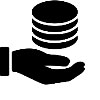How the White Tabel works
If you’re not a performing artist, you are payrolled via the white table arrangement. White table is a tax scheme for employees. Payrolling is fairly simple: first you make arrangements with your client regarding work. Secondly, you provide us with all specific information regarding your activities. Thirdly, we send an invoice to your client. Finally, when your client pays, we will transfer your net salary to your bank account the same day.
In order to be payrolled, we need the following information from you:
- Valid identification (no driver’s license): passport copy or ID card (both sides);
- Payroll tax declaration / income tax statement (in case of a temporary employment contract);
- Work data (via temporary / contract agreement or online via My Artiestenverloningen).
For more information and further insight into the payroll procedure, we explain everything in detail below.

Step 1: Make work agreements with your client
Make work agreements with your client, such as date, place, hours and rate. You can register these agreements in a temporary employment contract or contract agreement of Wittetabelverloningen. You can use our standard contracts that were drafted in consultation with lawyers of trade unions NTB and Art Association (former FNV-KIEM).
Note: A contract agreement should be used only if there is no so called ‘relationship of authority’, for example when you design a website or theatre decor. No premiums are deducted with a commission contract. Please sign the agreement and make sure that your client does the same. This way, you have a solid legal position in case of any disputes.

Step 2: Send in payroll assignment
Please send us all relevant information in order to payroll you, either via a standard agreement or online via My Artiestenverloningen. In order to register you, we need a clear scan of your valid identity document (no driver’s license) and, in case of a temporary employment contract, a signed income tax statement.

Step 3: Invoice procedure
After receiving your assignment, we will send an invoice to your client. The client has 21 days to pay the invoice. Optionally, the client may agree to a different payment period, from 7 up to 90 days. If your client does not pay on time, they will receive a reminder invoice after three weeks; a second reminder after two additional weeks and finally a legal notice of default.

Step 4: Nett salary and holidat allowance
When your client pays the invoice, we will transfer your salary and holiday allowance to your bank account the same day. (Provided that we have all your data, such as a valid passport copy and bank account number). You will receive a digital salary specification of your payrolling that same day. Holiday allowances are paid annually at the end of May. You can also choose to receive your holiday allowance immediately after each salary payment.

Step 5: Income tax and social insurances
We pay your income tax to the Dutch Tax Office and pay social insurance premiums to UWV (Institute for Employee Insurance). Therefor, you can rely on social insurances (only for temporary employment contracts) in case you fall ill or become unemployed.
Step 6: Annual tax statement
After the end of each calendar year (January), you receive an annual tax statement by e-mail. You need this for your income tax return to the Dutch Tax Office (from March 1st).
